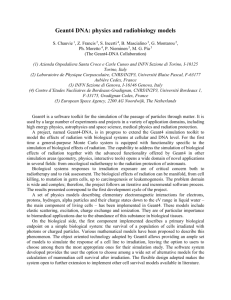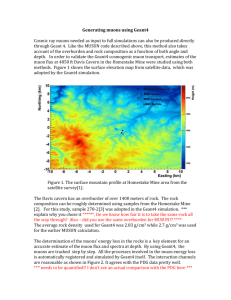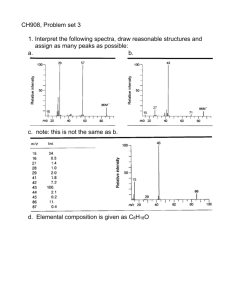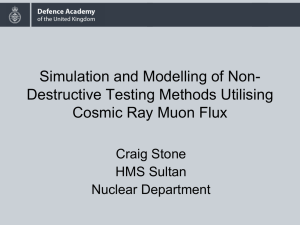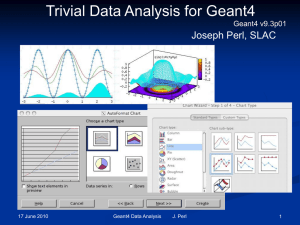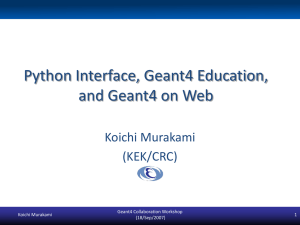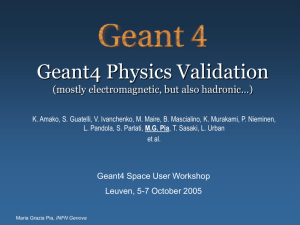Cross Sections
advertisement
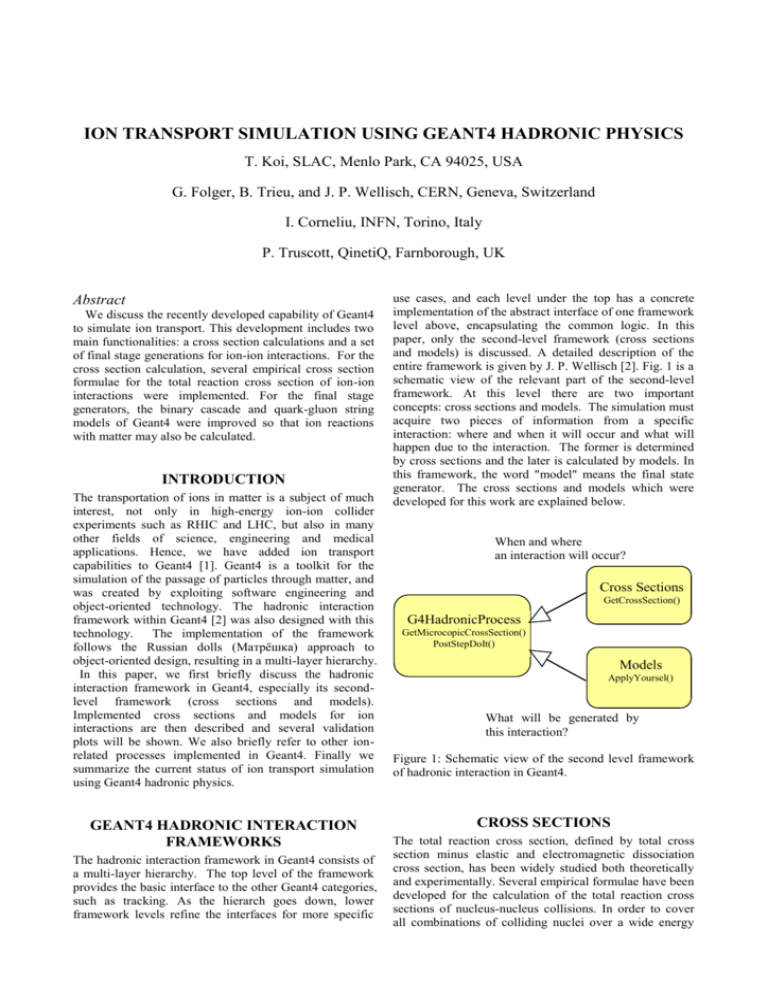
ION TRANSPORT SIMULATION USING GEANT4 HADRONIC PHYSICS T. Koi, SLAC, Menlo Park, CA 94025, USA G. Folger, B. Trieu, and J. P. Wellisch, CERN, Geneva, Switzerland I. Corneliu, INFN, Torino, Italy P. Truscott, QinetiQ, Farnborough, UK Abstract We discuss the recently developed capability of Geant4 to simulate ion transport. This development includes two main functionalities: a cross section calculations and a set of final stage generations for ion-ion interactions. For the cross section calculation, several empirical cross section formulae for the total reaction cross section of ion-ion interactions were implemented. For the final stage generators, the binary cascade and quark-gluon string models of Geant4 were improved so that ion reactions with matter may also be calculated. INTRODUCTION The transportation of ions in matter is a subject of much interest, not only in high-energy ion-ion collider experiments such as RHIC and LHC, but also in many other fields of science, engineering and medical applications. Hence, we have added ion transport capabilities to Geant4 [1]. Geant4 is a toolkit for the simulation of the passage of particles through matter, and was created by exploiting software engineering and object-oriented technology. The hadronic interaction framework within Geant4 [2] was also designed with this technology. The implementation of the framework follows the Russian dolls (Матрёшка) approach to object-oriented design, resulting in a multi-layer hierarchy. In this paper, we first briefly discuss the hadronic interaction framework in Geant4, especially its secondlevel framework (cross sections and models). Implemented cross sections and models for ion interactions are then described and several validation plots will be shown. We also briefly refer to other ionrelated processes implemented in Geant4. Finally we summarize the current status of ion transport simulation using Geant4 hadronic physics. GEANT4 HADRONIC INTERACTION FRAMEWORKS The hadronic interaction framework in Geant4 consists of a multi-layer hierarchy. The top level of the framework provides the basic interface to the other Geant4 categories, such as tracking. As the hierarch goes down, lower framework levels refine the interfaces for more specific use cases, and each level under the top has a concrete implementation of the abstract interface of one framework level above, encapsulating the common logic. In this paper, only the second-level framework (cross sections and models) is discussed. A detailed description of the entire framework is given by J. P. Wellisch [2]. Fig. 1 is a schematic view of the relevant part of the second-level framework. At this level there are two important concepts: cross sections and models. The simulation must acquire two pieces of information from a specific interaction: where and when it will occur and what will happen due to the interaction. The former is determined by cross sections and the later is calculated by models. In this framework, the word "model" means the final state generator. The cross sections and models which were developed for this work are explained below. When and where an interaction will occur? Cross Sections GetCrossSection() G4HadronicProcess GetMicrocopicCrossSection() PostStepDoIt() Models ApplyYoursel() What will be generated by this interaction? Figure 1: Schematic view of the second level framework of hadronic interaction in Geant4. CROSS SECTIONS The total reaction cross section, defined by total cross section minus elastic and electromagnetic dissociation cross section, has been widely studied both theoretically and experimentally. Several empirical formulae have been developed for the calculation of the total reaction cross sections of nucleus-nucleus collisions. In order to cover all combinations of colliding nuclei over a wide energy range, the cross section formulae of Tripathi [3, 4], Shen [5], Kox [6] and Sihver [7] were implemented in Geant4. These are empirical and parameterized formulae which include theoretical aspects such as Coulomb barrier, Pauli blocking, asymmetric proton and neutron numbers and so on. Fig. 2 shows the calculated result of each formula for the collision of two 12C nuclei, together with some experimental data [6, 8] and theoretically calculated values [9]. Since there are many cross section formulae for nucleusnucleus collisions, the class G4GeneralSpaceNNCrossSection was prepared to assist users in selecting the appropriate cross section formula. time-independent optical potentials. A three-dimensional nuclear model is constructed from the atomic number and the mass number. The nucleon distribution follows the Woods-Saxon model [11] for heavy nuclei and the harmonic oscillator shell model [12] for light nuclei which have mass numbers smaller than 17. Nucleon momenta are sampled from 0 up to the Fermi momentum and the sum of these momenta is set to 0. The timeinvariant scalar optical potentials are used for the nuclear field effects. The time integration of the reactions is carried out as follows. First the impact parameter is sampled and the time to closest approach of the projectile to the nucleons in the nucleus is calculated. The reactions are selected according to the free hadron-nucleon cross section. Transportation of the system to the time of the first collision or decay is advanced. New products are created while taking the Pauli’s exclusion principle into account. This procedure is repeated for all products, hence allowing for re-scattering. In nucleus-nucleus interactions, two nuclei are prepared according to this three-dimentional nuclear model. The lighter nucleus is selected to be the projectile. Nucleons in the projectile are entered with position and momenta into the initial collision state. Until the first collision of each nucleon of the projectile, its Fermi motion is neglected in tracking. Fermi motion and the nuclear field are taken into account in collision probabilities and final states of the collisions. QGS-Glauber Figure 2: Comparison of total reaction cross sections of collisions between 12C and 12C. MODELS We improved the Binary Cascade model [10] and Quark Gluon String (QGS) model of Geant4 so that ion reactions with matter can be calculated. In this section we briefly explain both models together with points of improvement in the final state generators of ion interactions. Binary Cascade Light Ion The Binary Cascade model is based on a detailed threedimensional model of the nucleus, and exclusively based on binary scattering between reaction participants and nucleons within this nuclear model. This feature makes it a hybrid between a classical cascade code, and a quantum molecular dynamic (QMD) model. In the Binary Cascade model, similar to QMD, each participating nucleon is seen as a Gaussian wave packet and the total wave function of the nucleus is assumed to be the direct product of these without anti-symmetrization. The resulting equations of motion have the same structure as the classical Hamilton equations and can be solved numerically. However, unlike the QMD model where the Hamiltonian is self-generated from the system configuration, the Hamiltonian is calculated using simple In Geant4, parton string models are used for final state generations for inelastic interactions of hadrons with nuclei at high incident energies. Such models can be divided into two phases: string excitation and string fragmentation. Two models which have different approaches to the string excitation phase are implemented. One is based on diffractive excitation and the other (QGS model) is based on soft scattering with diffractive admixture according to cross sections. In the string fragmentation phase, two models have basically common treatments, using different fragmentation functions. In hadron-nucleus reactions in the QGS model, a threedimensional nucleus is built up in a manner similar to that of the Binary Cascade model and then collapsed to two dimensions. The impact parameter is sampled and then the hadron-nucleon collision probabilities are calculated based on the quasai-eikonal model. The number of Pomerons which are exchanged in each collision is sampled. String formation is done via parton exchange and the rearrangement mechanism. Produced strings enter into the string fragmentation phase so that secondary white hadrons are produced by string fragmentation. This fragmentation of a string follows an iterative scheme where a string produces a hadron and new string. The LUND model [13] fragmentation function is implemented and used not only for fragmentation but also for the decay of excited string. In order to achieve better three-reggeon behavior when the light cone momentum fraction is close to 1, the special fragmentation functions [14] of the QGS Figure 3: Comparison of double differential neutron production cross sections for the C beam at 290 MeV/n on Carbon between data [15] and Geant4 simulation. model are also implemented. Hadron formation points from string fragmentation are assumed to be given by the yo-yo formation point. The QGS model treats a hadron-nucleus collision as a set of quasai-independent hadron-nucleon collisions, correlated only through quark-content and energy conservation. In nucleus-nucleus reactions, according to the nucleus model of projectile ion, the additional primary nucleons are put into the reaction system. We have done the development, however, the latest release of Geant4 (version 6 with patch 02) does not yet includes this future yet. carbon, copper and lead. In both figures the simulation results and experimental data show reasonable agreement. Validation work is continuing for many aspects of nucleus-nucleus reactions such as charge exchange cross sections, projectile fragmented particle production, and so on. VALIDATION WITH EXPERIMENTS A validation suite has been developed to evaluate and optimize hadronic models in Geant4. We have performed several validations by comparing simulation results with experimental data, samples of which are shown in Figs. 3 and 4. Fig. 3 shows the double differential neutron production cross section for a 12C beam at 290 MeV/n bombarding a carbon target. Each plot corresponds to a different emission angle of secondary neutrons. Fig. 4 shows the double differential cross sections for negative pion production by a 12C beam at 1.05 (GeV/c)/n. The emission angle of secondary pions is 2.5 degrees and each plot corresponds to a different target material, beryllium, Figure 4: Comparison of double differential (2.5 deg.) negative pion production cross sections for the C beam at 1.05 (GeV/c)/n between data [16] and Geant4 simulation. Target materials are Beryllium, Carbon, Copper and Lead. OTHER ION RELATED PROCESSES IN GEANT4 Geant4 already has many other ions related processes such as, Ionization Energy Loss Multiple Coulomb Scattering Electromagnetic Dissociation Abrasion-Ablation Model Electromagnetic dissociation is the interaction between the projectile particle and virtual photons which appear when relativistic projectiles pass the target nucleus. The cross section of this process becomes especially important when projectile energies are ultra-relativistic and the atomic number of the nucleus is large. The Abrasion-Ablation Model is a simplified macroscopic model for nuclear-nuclear interactions based largely on geometric arguments rather than detailed consideration of nucleon-nucleon collisions. The computing speed of this model is faster than microscopic models such as the Binary Cascade and QGS-Glauber, making it a useful alternative. All of the above processes are integrated into ion transportation in Geant4. CONCLUSIONS We have developed functionalities for ion transport simulation in Geant4. Within the hadronic interaction framework of Geant4, cross sections for nucleus-nucleus reactions have been added and the Binary Cascade and QGS models have been extended to handle ion interactions. Fig. 5 shows that there is no significant gap the area covered by both cross sections and models for nucleusnucleus interactions. Geant4 now has abundant processes for ion interactions with matter and without any extra modules, users may simulate ion transportation using the complex and realistic geometries of Geant4. Validation has begun and the first results show reasonable agreement with data. This work continues. ACKNOWLEDGEMENTS The authors would like to express thanks to Dr. D. Wright for careful reading the manuscript. The work of T. K. was supported by Department of Energy contract DEAC03-76SF00515. Tripathi & TripathiLightSystem ~10 GeV/A Cross Sections Kox & Shen ~10 GeV/A ~100 MeV/A Sihver 100 MeV/n 1 GeV/n 10 GeV/n Binary Cascade Light Ions ~ 10 GeV/A Models ~5 GeV/A QGS – Glauber (Not yet included in the release) Figure 5: Area covered by models and cross sections for ion interactions. REFERENCES [1] GEANT4 Collaboration S. Agostinalli et al., Nucl. Instr. Meth. A506 (2003) p. 250. http://geant4.web.cern.ch/geant4/ [2] J. P. Wellisch, Comp. Phys. Comun. 140 (2001) p.65. [3] R. K. Tripathi, F. A. Cucinotta and J. W. Wilson, NASA Technical Paper TP-3621 (1997). [4] R. K. Tripathi, F. A. Cucinotta and J. W. Wilson, NASA Technical Paper TP-209726 (1999). [5] S. Kox et al., Phys. Rev. C 35 (1987) p. 1678. [6] Wen-qing Shen et al., Nucl. Phys. A 49 (1989) p. 1130. [7] L. Sihver et al., Phys. Rev. C 47 (1993) p. 1225. [8] J. Jaros et al., Phys. Rev. C 18 (1978) p. 2273 [9] P. J. Karol Phys. Rev. C11 (1975) p. 1203 and T. Brohm K. -H. Schmidt, Nucl. Phys. A 569 (1994) p. 821. [10] G. Folger, V. N. Ivanchenko and J. P. Wellisch, Eur. Phys. J. A21 (2004) p. 407. [11] M. E. Grypeos et al., J. Phys. G17 (1991) p. 1093. [12] L. R. B. Elton, Nuclear Sizes, Oxford University Press, Oxford, 1961. [13] B. Andersson et al., Phys. Rep. 97 (1983) p. 31. [14] A. B. Kaidalov, Sov. J. Nucl. Phys. 45 (1987) p. 1452. [15] Y. Iwata et al., Phy. Rev. C64 (2001) p. 054609. [16] J. Papp Thesis ref - LBL-3633 (1975).
